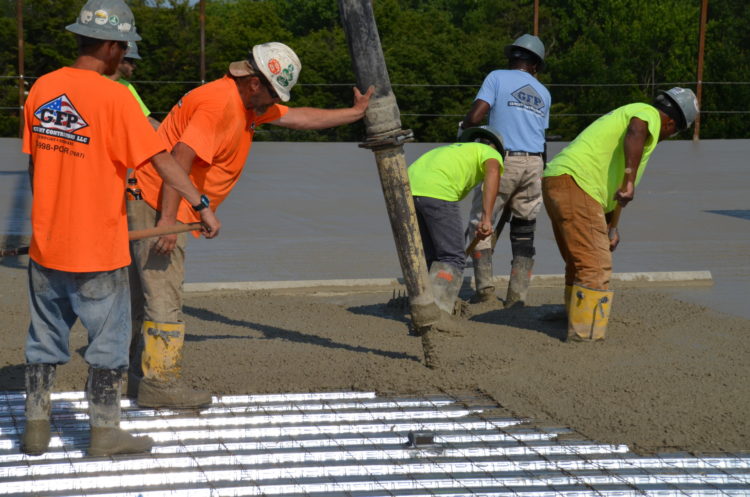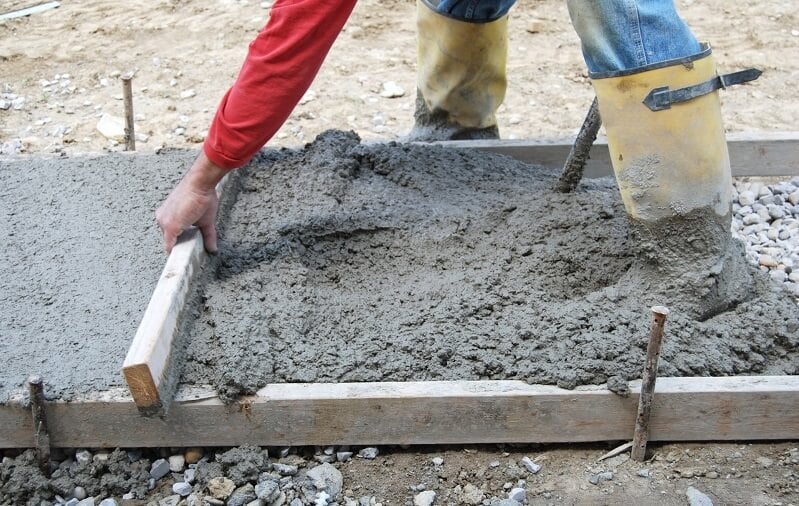Everything about Concrete: Crucial Services for Residential and Commercial Building
Concrete is an essential element in the building sector, serving both business and household requirements. Its one-of-a-kind composition offers stamina and longevity, making it suitable for various applications. From foundational work to ornamental surfaces, concrete plays a substantial duty in boosting structural stability and aesthetic charm. There are several subtleties to ponder when functioning with this flexible material. The exploration of its essential solutions exposes much more than meets the eye.
Understanding the Basics of Concrete
Concrete, a fundamental material in construction, is made up of a combination of concrete, water, aggregates, and ingredients. This flexible compound is known for its durability, flexibility, and stamina, making it a preferred option for various applications. The cement acts as a binding representative, while aggregates supply bulk and toughness. Water is vital for the hydration procedure, which transforms the mix into a solid mass. Additives can modify the residential properties of concrete, such as establishing time and workability, allowing for customized solutions to certain project demands.
Concrete can be cast right into different shapes and sizes, making it ideal for everything from pathways to skyscrapers. Its capability to hold up against compressive pressures makes it perfect for architectural parts. Furthermore, its thermal mass adds to power efficiency in buildings. Understanding these fundamental aspects of concrete is essential for anyone included in the construction market, as it lays the foundation for effective job implementation.

Necessary Concrete Providers for Foundations
Foundations play a significant role in the security and longevity of any structure, and concrete services are fundamental in their construction. A trustworthy concrete structure guarantees that the weight of the building is evenly distributed, reducing the risk of working out or moving. Essential services include website preparation, in which the ground is graded and compressed to develop a solid base. Concrete putting follows, making use of high-quality materials to create a resilient slab or grounds made to stand up to numerous ecological problems.
Reinforcement, commonly with steel rebar, includes toughness to the structure, avoiding cracks and architectural failures. Appropriate treating strategies are likewise important, permitting the concrete to attain its excellent toughness gradually. In addition, waterproofing measures can be implemented to shield versus moisture invasion, which is vital for preserving the honesty of the structure. These important concrete solutions collectively add to a durable foundation, creating the backbone of any kind of effective building and construction project.
Driveway Setup and Upkeep Options
In the domain of driveway installment, numerous materials such as concrete, asphalt, and crushed rock supply distinctive benefits and visual appeals. Comprehending these options is crucial for homeowners looking for toughness and charm. Furthermore, implementing effective maintenance approaches can greatly prolong the lifespan and capability of a driveway.

Types of Driveway Products
Driveways function as essential paths for lorries, and the option of products substantially affects their look, sturdiness, and maintenance demands. Typical driveway materials consist of concrete, asphalt, crushed rock, pavers, and bricks. Concrete driveways are recognized for their strength and long life, while asphalt offers adaptability and a smooth coating. Crushed rock driveways are very easy and cost-effective to set up, providing good drainage but needing even more upkeep. Pavers and bricks offer visual allure and versatility in design, yet they can be extra labor-intensive to set up. Each material has unique attributes that accommodate different preferences and budgets, making it essential for property owners and home builders to carefully consider their alternatives when picking driveway products for residential or industrial tasks.
Maintenance Tips for Sturdiness
Choosing the appropriate materials for driveways is just the beginning; effective maintenance is essential for guaranteeing their longevity and performance. Routine cleansing is essential, as oil, debris, and dust can degrade the surface. Home owners should consider sealing their concrete driveways every few years to safeguard against dampness infiltration and freeze-thaw cycles. Cracks need to be resolved promptly; small fissures can swiftly broaden if left neglected. Furthermore, it is suggested to avoid heavy lots and sharp things that can harm the surface. Mounting correct drainage systems can avoid water buildup, which is vital for maintaining structural honesty. Ultimately, routine assessments help identify potential issues early, enabling timely repair services and extending the driveway's life expectancy substantially.
Attractive Concrete Finishes for Visual Appeal
While many associate concrete mostly with functionality, attractive concrete finishes have actually emerged as a popular selection for improving aesthetic appeal in various building and construction tasks. Concrete Contractor Near Me. These finishes change average concrete into visually striking surfaces, ideal for both industrial and property applications. Methods such as stamping, staining, and polishing permit a range of appearances, patterns, and shades, allowing useful site developers to resemble natural products like stone or wood
Amongst the numerous options, stamped concrete supplies an economical method to accomplish detailed styles, while acid staining adds deepness and vibrancy to surfaces. Refined concrete, on the other hand, provides a smooth, modern-day appearance, ideal for modern rooms. Furthermore, exposed accumulation surfaces can showcase vibrant stones, adding an unique touch to outside locations. In general, attractive concrete coatings not just boost the aesthetic allure of rooms yet likewise add to the longevity and durability of concrete surface areas in a stylish fashion.
Concrete Repair Service and Restoration Techniques
Resolving concerns of wear, damage, or degeneration in concrete surfaces is essential for maintaining architectural honesty and aesthetic appeal. Numerous concrete fixing and restoration strategies are employed to restore surface areas to their original condition. Split securing is a typical method, involving the use of specific materials to fill up and stop further damage. For extra comprehensive repair services, epoxy injection can be utilized to bond and reinforce broken sections. Surface area spalling usually calls for resurfacing, where a new layer of concrete is used to enhance durability and appearance. Additionally, concrete overlays provide an effective option for bring back used surfaces while using layout flexibility. In situations of severe degeneration, total substitute may be needed. Appropriate analysis and prompt treatment are very important in figuring out one of the most reliable repair service approach, consequently lengthening the lifespan of concrete frameworks and making sure safety and security for property and commercial applications.
Environmental Considerations in Concrete Building And Construction
Ecological factors to consider play a vital role in modern-day concrete construction practices. Highlighting sustainable product choices, reliable waste management practices, and techniques for carbon footprint decrease can significantly improve the environmental effect of building jobs. As the sector progresses, attending to these elements comes to be significantly crucial for advertising sustainability.
Lasting Product Options
As the building and construction market progressively focuses on sustainability, the expedition of sustainable material choices in concrete building and construction has actually acquired substantial focus. Traditional concrete mixes generally count on Rose city cement, which has a significant carbon impact. Alternatives such as fly ash, slag concrete, and recycled concrete aggregates are being used to minimize ecological impact. Furthermore, bio-based admixtures and innovative techniques like carbon capture and usage are emerging, even more boosting the sustainability of concrete. These products not only reduce waste yet also enhance the efficiency and toughness of concrete frameworks. By integrating lasting alternatives, the building market can add to a circular economy, reduce greenhouse gas emissions, and advertise responsible resource management while meeting the expanding demand for environmentally friendly structure methods.
Waste Monitoring Practices
Effectively taking care of waste is important in concrete building, where substantial materials can be shed during manufacturing and demolition procedures. Implementing durable waste management techniques not just conserves resources however also lessens environmental influence. Reuse and recycling of concrete debris are essential strategies, allowing the recuperation of aggregates for brand-new mixes. Furthermore, correct sorting of products at task websites can minimize contamination and increase recycling prices. Utilizing lean building and construction methods even more boosts effectiveness by maximizing material usage and lowering excess waste. Education and learning and training of workers in reliable waste monitoring practices assure adherence to guidelines, cultivating a society of sustainability. In general, these techniques add to a more environmentally accountable strategy in the concrete market, sustaining both business and property projects.

Carbon Impact Decrease
Waste administration techniques set the phase for resolving the carbon impact connected with concrete construction. The production of concrete is recognized to generate substantial greenhouse gas emissions, largely from concrete manufacturing. To reduce this effect, numerous strategies have arised. Making use of alternate materials, such as recycled accumulations and commercial byproducts like fly ash, assists lower dependence on standard concrete. Advancements in concrete formulations, consisting of the development of low-carbon and carbon-absorbing concrete, contribute to sustainability goals. Implementing energy-efficient techniques in blending and curing processes also plays a vital duty. In addition, optimizing transportation logistics lessens emissions connected with supplying concrete. By embracing these procedures, the you can check here construction industry can significantly lower its carbon impact while advertising green methods.
Frequently Asked Questions
How Lengthy Does Concrete Take to Cure Completely?
Concrete usually takes 28 days to treat entirely, reaching its perfect stamina (Concrete Contractor Near Me). Nonetheless, preliminary setting happens within hours, and it can sustain light tons after a couple of days, relying on environmental problems and mix structure
Can I Pour Concrete in Winter?
Yes, concrete can be gathered winter, yet safety measures are essential. Proper insulation, utilizing warm water, and additives can help ensure look at this web-site adequate treating and avoid freezing, which might endanger the integrity of the concrete.
What Is the Ordinary Life-span of Concrete Structures?
The typical life-span of concrete frameworks generally ranges from 30 to 100 years, depending on factors such as environmental conditions, upkeep techniques, and the top quality of materials made use of in building.
Is Concrete Recyclable After Demolition?
Yes, concrete is recyclable after demolition - Concrete Contractor Near Me. It can be crushed and repurposed for different applications, such as new building and construction, road base, and landscape design. This process helps reduce waste and preserves natural sources
Just how Do I Pick the Right Professional for Concrete Job?
To choose the appropriate specialist for concrete work, one ought to verify credentials, examine previous jobs, reviewed evaluations, and acquire numerous quotes. Clear communication about project expectations and timelines additionally plays a vital role in the choice process.
Concrete, a basic product in building, is made up of a blend of cement, water, aggregates, and ingredients. While many associate concrete mostly with capability, decorative concrete surfaces have actually arised as a prominent choice for boosting visual charm in various construction projects. As the building industry significantly focuses on sustainability, the exploration of lasting material choices in concrete construction has actually obtained significant focus. Successfully managing waste is vital in concrete construction, where considerable products can be lost during manufacturing and demolition processes. Innovations in concrete formulations, including the advancement of low-carbon and carbon-absorbing concrete, add to sustainability goals.